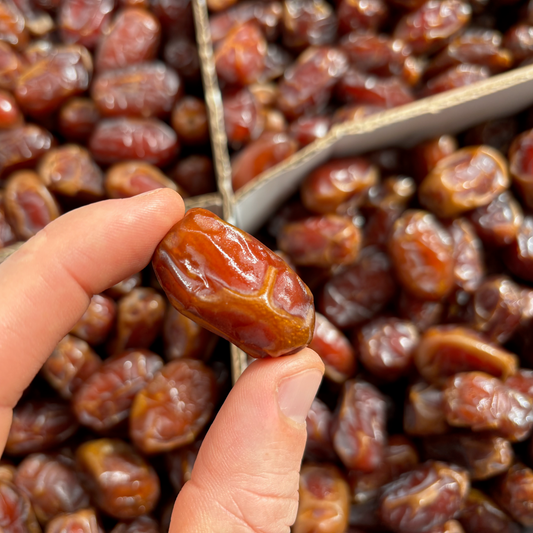fruit notes
Kenny and Molly of Lonely Mountain Farm grow an amazing variety of fruits, vegetables, and flowers. This week, they’re harvesting late-season varieties of feijoas, also known as pineapple guavas. Both the Apollo and Wiki Tu varieties ripen later in the season, while many others are harvested in September. These feijoas are super fragrant and tropical! You can peel the skin or cut them in half and scoop out the interior flesh. The thin green skin is edible but can be slightly bitter. They’re ripe now but can also be left to soften slightly on the counter. Sweet, fragrant, and with a meaty texture! Store on the counter. Grown organically by Lonely Mountain Farm in Watsonville.
Pomegranates are one of the oldest cultivated fruits, originating in Iran, where wild pomegranates can still be found! Toby’s planted some new varieties of pink pomegranates including these, called Pink Satin. Their arils range in color from white to pink to light red, and the seeds are softer than many classic red pomegranate varieties. The juice is sweet with no acid, giving it a fruity punch flavor! We love that Toby picks his pomegranates perfectly ripe. Store in the fridge or on the counter. Grown organically by Free Spirit Farm in Winters.
Sandra Newman and the crew at Forbidden Fruit Orchards grow amazing blueberries during California’s “off season.” Their farm is perfectly situated on a southern slope 12 miles from the ocean, in an area protected from frost. At the western edge of the Santa Ynez wine-growing region, the mountain range funnels in cool, temperate weather, allowing for a longer hang time and slower ripening. This longer ripening period and ideal climate yield wonderful flavor and a firm texture! Right now, they’re harvesting their Sapphire blueberries. Store in the fridge. Grown organically by Forbidden Fruit Orchards in Lompoc.
Fuyu persimmons are finally ripe and ready for harvest! Toby lets his Fuyus hang a bit longer for a more fully developed flavor. They have a sweet, honey-like taste and can be eaten firm. If you like them slightly softer, you can leave them on the counter for a bit. We know some of you like them crunchy crunchy, so we wanted to give you the option! Store on the counter. Grown organically by Free Spirit Farm in Winters.
Cathy and Michael of Spreadwing Farm take their persimmons really seriously. Michael even wrote us a rant on persimmons last fall. Chocolate persimmons look a bit like Hachiyas – the astringent, bell-shaped persimmons – but these are typically sweet even when firm. I say typically because their transfiguration from unpalatable to delicious relies on pollination, which requires a bit of faith. Cathy and Michael are always a bit nervous to send them firm; on the off-chance someone were to bite into an unpollinated fruit, it would mean a wallop of astringency that could ruin persimmons for them forever. It took some convincing, but they obliged. Chocolate persimmons are so good that I couldn’t skip them this season. The perfect stage to eat them is when they have just a little softness—not quite as ripe as you’d want a Hachiya, but with a bit of give. The interior is a deep brown, chocolate color, and the flavor is out-of-this-world sweet and delicious. (The darkest brown parts are the best-tasting!) It’s a finicky variety because it relies on unpredictable pollination, but the rich taste is the payoff. Brown coloration in the interior indicates that they've been properly pollinated and you're good to go. If you’re worried, you can wait until they’re fully soft, like persimmon pudding. Store on the counter and wait to soften slightly (or fully to pudding stage). Grown organically by Spreadwing Farm in Rumsey.
It’s really hard to pick a favorite apple from Stan Devoto because they’re all so good! We’re in the middle of local apple season and the diversity of varieties is incredible. We’re spoiled for choice, and I still always get excited about Winesap apples. They have a complex wine-like flavor and a dense and juicy bite. Winesaps start sweet and have the slightest tart finish. The skin is on the thicker side, so I like to eat this apple sliced. Store in the fridge on or on your counter. Grown organically by Devoto Orchards in Sebastopol.
On the Central Coast, tamarillo is a fall fruit. If you’re new to tamarillo, it’s also known as tomate de árbol (tree tomato), a fruit native to the Andes. The skin and outer flesh tend to be bitter, so we like to cut them in half and scoop out the seeds and inner flesh. We learned a cool trick this past spring from farmer Kristen Ruskey. She likes to bite the tip off a tamarillo and suck out the juicy plump – so fun! It tastes like guava and melon crossed with savory tomato, wildly complex! Store on the counter. Grown organically by Condor Ridge Ranch in Goleta.
The last week of October means the last week of California Keitt mangoes! These green-skinned mangoes help ease us into fall fruit with so much brightness. After 2-4 days on the counter (depending on how warm your space is), they’ll go from firm to having a slight give, like a ripe avocado. They’ll stay green but turn wonderfully sweet and juicy! Store on the counter. Grown organically by Ava’s Mangos in the Coachella Valley.





